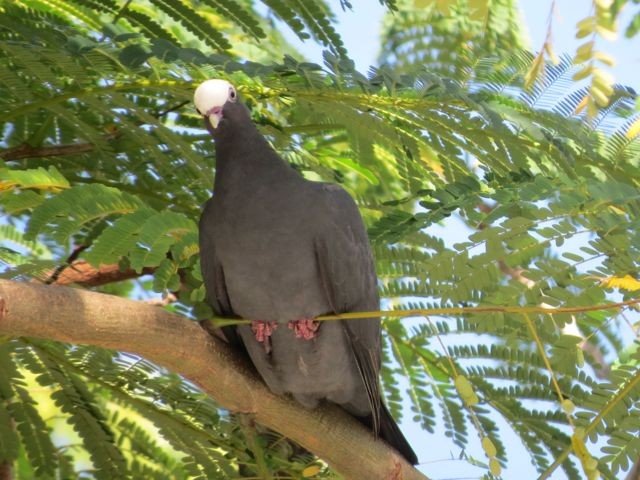White-crowned Pigeon
A species of American Pigeons Scientific name : Patagioenas leucocephala Genus : American Pigeons
White-crowned Pigeon, A species of American Pigeons
Botanical name: Patagioenas leucocephala
Genus: American Pigeons
Content
Description People often ask General Info
Description
The white-crowned pigeon can measure 29–35 cm (11–14 in) in length, span 48–59 cm (19–23 in) across the wings, and weigh 150–301 g (5.3–10.6 oz). It is around the same size as the common rock pigeon, but weighs a bit less since it is generally less chunky and has a relatively longer and more square tail. Adult birds' plumage varies from a slate gray to an almost-black color. Its iridescent collar-patch is notably only seen under good lighting, shining a barred white pattern with green. Their distinct crown-patch can vary in shade of color from a more bright white in males to a more gray-white in most females. Juveniles can have a grayish-brown color for They have a white iris and a pale-tipped red bill. Juveniles are a less dark shade of grey, lack the nape pattern and white iris, and show only a few pale feathers on the crown. Their call is a loud, deep coo-cura-coo or coo-croo. This species is a member of a diverse clade of Patagioenas which vary much in appearance, but are united by their triple coos (except in the scaled pigeon). 
Size
28-38 cm (11-15 in)
Colors
Black
Gray
White
Life Expectancy
14 years
Nest Placement
Tree
Clutch Size
1 - 3 eggs
Feeding Habits
White-crowned Pigeon's diet consists primarily of ripe fruits from West Indian trees and shrubs. They occasionally eat wasps, flies, small snails, seeds, or flowers, and ingest grit and salt for digestion. They can travel over 30 miles for food, feeding in treetops or sometimes on the ground, swallowing most fruits whole and feeding their young with protein-rich crop milk.
Habitat
White-crowned Pigeon typically inhabits tropical and subtropical regions, favoring coastal areas. Specifically, white-crowned Pigeon thrives in mangrove forests, interspersed with native flora like gumbo-limbo and seagrape trees. They nest in environments largely free from predators, crucial for their survival. To forage, white-crowned Pigeon ventures to diverse ecosystems, including moist tropical forests and higher elevation areas with abundant fruit-bearing vegetation. These habitats are generally at low altitudes, with warm, humid climates favorable for evergreen and semi-evergreen species.
Nest Behavior
Both male and female white-crowned Pigeon collaborate on building the nest. The species displays territorial behavior with males selecting the site.
Nest Characteristics
White-crowned Pigeon nests are typically located over 6 feet off the ground in trees, constructed as a platform of small twigs with a lining of finer twigs, having a somewhat unkempt appearance.
Dite type
Frugivorous
People often ask
General Info
Feeding Habits
Bird food type

Fruit
Bird Feeder Type

Platform
Behavior
White-crowned Pigeon exhibit a range of behaviors that are closely tied to their habitat and daily activities. They are known to form substantial colonies, especially during the breeding season, with nest territories defended primarily around the nest's immediate vicinity. A quintessential day for white-crowned Pigeon involves foraging for fruit, which dictates their breeding schedules, aligning with the times of fruit abundance. Courting rituals are distinct, with males conducting a showy but calculated flight display followed by a series of bows, coos, and tail spreads. Pairs demonstrate affection through mutual preening, highlighting a strong bond. Seasonal migrations are common among white-crowned Pigeon, with many relocating to warmer climates or island habitats like the Bahamas during winter months, showcasing their adaptability to environmental changes.
Distribution Area
It is a resident breeder mainly in the Bahamas, Cuba, Jamaica and Antigua. It breeds in smaller numbers in Hispaniola (Dominican Republic and Haiti), Puerto Rico, the Virgin Islands, the Cayman Islands, Anguilla and other Caribbean islands. It also breeds along the Caribbean coast of Central America. In the United States it is found only in the Florida Keys, Everglades, and the southern tip of mainland Florida. They will often spend the wintertime in the Caribbean islands. The white-crowned pigeon primarily lives and breeds in nest colonies or individually in low lying, coastal, mangrove forests, and will travel inland to feed on the fruits and seeds of a wide variety of plants. In Florida, the white-crowned pigeon has historically been documented nesting exclusively on remote, tidally inundated mangrove islands in wildlife refuges. Recent observations have confirmed nesting on the southern tip of mainland Florida. With few exceptions, this species requires isolated offshore mangrove islets with limited disturbance for breeding. These tidally inundated mangrove islands which provide some protection from predators such as raccoons. However, several instances of white-crowned pigeons nesting in heavily-trafficked, urban areas, such as downtown Key West and Miami Florida, have recently been observed. This could be due to habitat loss as a result of hurricanes, and/or increased predation pressure in their historic nesting habitat. 
Species Status
The main threat to this species is hunting. In Florida a major cause of mortality is collision with man-made objects. Another main threat to this species is loss of habitat. The white-crowned pigeon needs two distinct habitats, one for nesting and one for feeding. They typically breed in coastal red mangroves (Rhizophora mangle), which continue to be clear-cut for crops such as sugarcane. Agriculture and deforestation have become a problem for the species' feeding grounds, typically inland hardwood forests. The bird is very skittish, and is known to simply abandon its nest when it is encroached upon. Like the extinct passenger pigeon this species "illustrates a very important principle of conservation biology: it is not always necessary to kill the last pair of a species to force it to extinction. These birds are "threatened by the slaughter of nesting birds on its Caribbean breeding grounds." 
Scientific Classification
Phylum
Chordates Class
Birds Order
Pigeons and doves Family
Dove Genus
American Pigeons Species
White-crowned Pigeon 